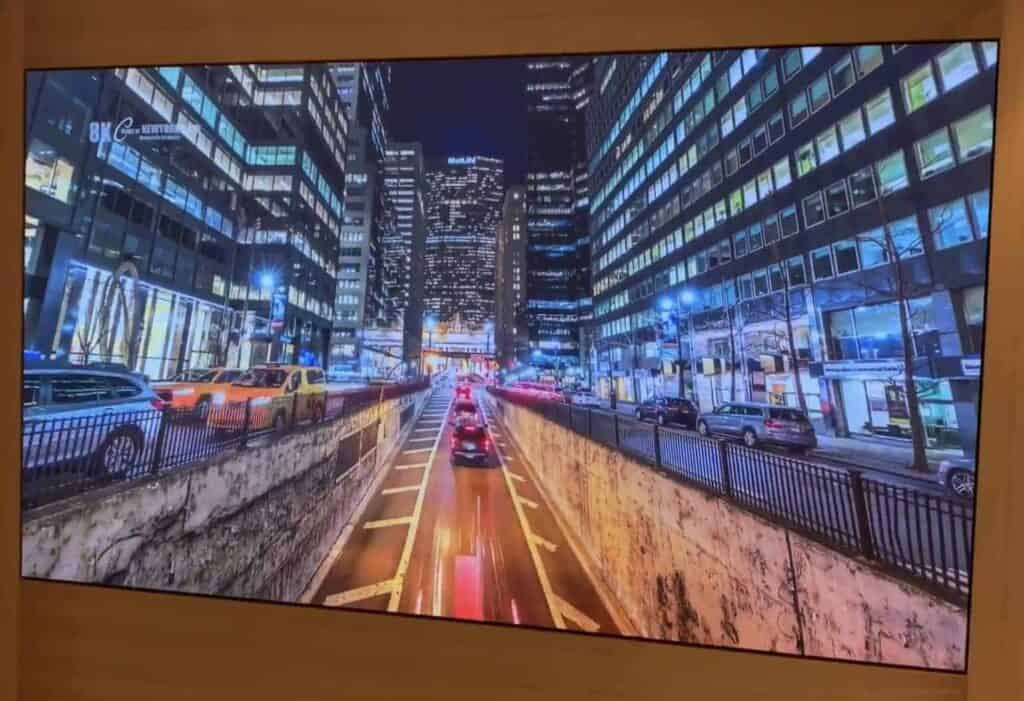Here we outline some of the key factors you should consider when you first set out to buy an LED screen
Table of Contents:
- LED Display, LCD or Projection?
- Choosing An LED Supplier
- What is an LED?
- The Main Types Of LED
- Custom LED Screen configurations
- LED Pixel Pitch
- Technical LED Specifications
- Low VS High Quality LED Displays
- LED Mounting Solutions
What Size LED Display?
We believe that an LED display or screen should be as big as possible. After all, there is no limitation on size, and the bigger the display, the more of an impact it makes!
What Is a Good Pixel Pitch?
Some people say that the pixel pitch should reflect how far away the viewer will be standing, and this, in turn, should dictate the pitch size, but this is simply not the case. One way to look at this is to consider, for instance, a standard 55″ television with an HD resolution of 1920 x 1080 pixels and compare this to another 55″ TV, but this time with a 4k resolution of 3840 x 2160 pixels. The 4k resolution looks far more impressive, but the physical screen size is exactly the same. We can use this same comparison with LED displays. The bigger the LED screen and the more overall pixels (resolution), the better looking the display. That being said, a very good rule of thumb for newcomers to LED is that for every 1m you stand away from the screen, you should have 1mm of pixel pitch. So, for example, if you don’t want to see each individual pixel when viewing from 2m, you should have a pixel pitch of 2mm, and for 3m, it should be 3mm, and so on.
What Size LED TV Should You Buy?
When talking about CRO tube televisions, their panels weren’t made of ultra 4K or HD technologies. As a result, your eyes failed to catch on any imperfections in the display panel. However, when you are buying an LED screen, you will have to consider the size of the TV screen for the best results. If the screen is too small and doesn’t have a high enough pixel density, the image will appear pixelated. The same goes for if the LED screen is very large, although a very big screen typically doesn’t need a low pixel pitch as you can achieve a high resolution with a relatively small pixel density.
As traditional screens are now based on ultra 4K or High Definition technology, they are usually viewed from a close distance and achieve a good viewing resolution. Most LED screens are fairly big in comparison, and this is where they show an advantage over traditional displays.
In the case of LED display panels, the size of the screen is usually above that of a traditional 80″ LED panel, and even at this size, the pixel pitch would need to be fairly low. That isn’t to say that a direct view LED screen has to have a similar resolution to a traditional TV screen because the direct view LED delivers a different kind of image. For instance, a traditional TV screen may have an HD resolution of 1920 x 1080 pixels but a direct view LED display would still deliver a very crisp and vivid image at far less than this. One thing to consider is that the closer you view a direct view LED display the more visible the individual pixels become.
A Buyer’s Guide
LED video walls are an incredible way to attract attention and showcase your most important messages in a vivid and exciting manner. They can be used in multiple environments and LED displays are fast becoming the preferred solution, taking over where LCD video walls and projectors once ruled. These types of screens really do have the ability to create lasting impressions and posses the ultimate visual “wow factor”. BUT BEWARE! Although the cost of LED displays has dropped dramatically over the past few years, the cost of buying the wrong solution can prove to be an expensive mistake!
There are multiple elements to take into consideration when purchasing an LED display, so we have put together this guide to help you make sure you have all the information you need to make the right decision.
What To Look For
We’ve laid down all the important steps that you need to take when buying the right display for your needs.
Please share your comments and questions below and feel free to check our led screen hire services worldwide!
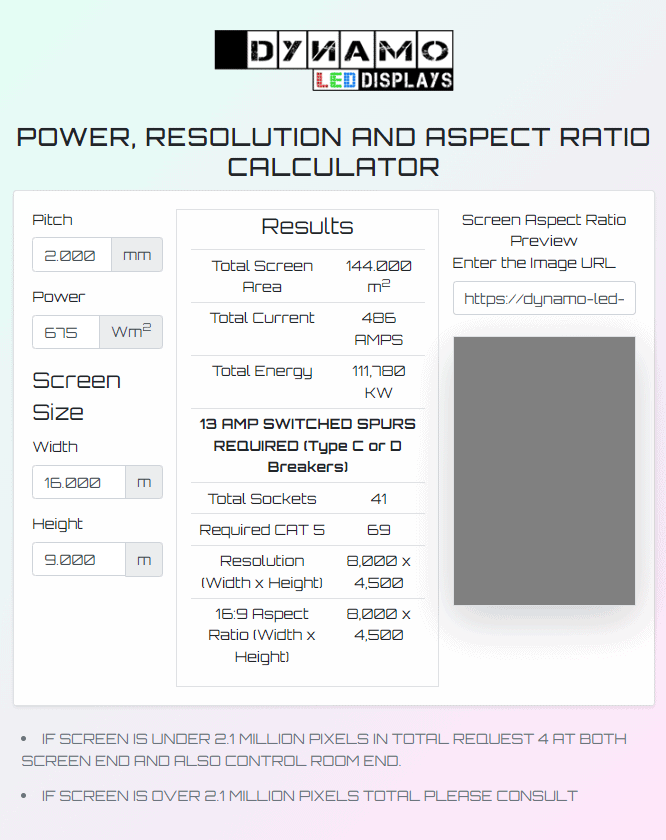
LED Display, LCD or Projection?
For most video wall applications LED is fast becoming ing the solution of choice. That’s not to say that there is no longer any place for LCD or projection, for instance, if you require a relatively small screen with a high resolution then LCD is the way to go. And likewise, if you have no issues with low ambient light levels then sometimes projection can be a viable solution. But with that being said LED is normally a far superior product when it comes to video displays, they have far superior brightness levels, higher contrast levels, and are generally cheaper to run. They do not suffer from burn-in like LCD video walls and they do not have the same issues with calibration that sometimes means that one or LCD screens in an array will have a different colour balance and look out of place. That’s not even mentioning the unsightly and distracting bezel lines that are created when LCD screens are joined together!
Choosing an LED Supplier
Always make sure you do your research when choosing an LED display company to carry out your installation. Make sure not to just visit their showroom but to, more importantly, visit their projects in the field and speak with their clients to see how they rated the experience. You would be shocked to discover the number of companies that showcase projects on their websites that they had absolutely no involvement with! Another good indicator is to check that the displays you are being shown do not give off a substantial amount of heat. This is a telltale sign of low quality LED. Ask the supplier to show you the LED screen on full white. Does the colour look a little red, yellow, or green? Good quality LED display should be able to show a brilliant full white. Always be clear to check the warranty! Most companies offer a return to base warranty, which is all well and good when you are made fully aware of this, but it can come as quite a shock when one month after installation, your LED screen is malfunctioning, and you are informed that your display is only covered on a return to base warranty! Here at Dynamo, we offer a free of charge 1-year service contract on all of our installations, meaning that in the unlikely event of any issues, we will aim to be on-site within 24 hours to rectify the problem.
What is an LED?
Simply put, an LED or light-emitting diode is a semiconductor that emits a light when an electrical current is passed through it. They are made from elements from group three and group five on the periodic table, also known as III-V materials. Good examples of these materials include gallium arsenide and gallium phosphide.
The first creation of an LED was by Russian scientists in 1927, although LED technology, as we know it, was first developed just after World War II when there was a huge interest in finding materials that could detect light and microwave waves. It was soon realized that these same materials could not only detect but also create light.
It wasn’t until the 1970’s that LEDs became commonplace with Hewlett Packard and Texas Instruments among the first to produce items that incorporated LEDs due to a reduction in manufacturing costs. Before, these LEDs sometimes had to be suspended in nitrogen to stop them from burning out, and even then, they were extremely inefficient and produced only a small amount of luminance.
The Main Types of LED
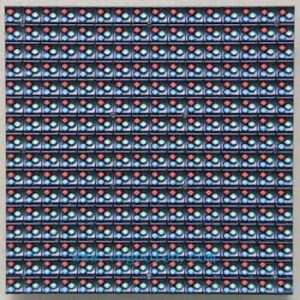
DIP LED or “dual in-line package” is probably the kind of LED most people are familiar with. They are the type of LED that is encased in a rounded plastic cover, which is coloured a specific shade with metal legs, the positives usually a little longer than the others to distinguish the polarity. The plastic encapsulation can also be designed as a lens which can focus the light in a specific direction, so unlike common light bulbs, they do not require reflection to direct light at the right audience. DIP LEDs have a reputation for being the brightest LEDs when it comes to LED displays and are also normally the most reliable LEDs when used in harsh weather environments.

SMD LED or “surface mount devices” are becoming more and more popular due to the fact they use less energy than their DIP predecessors and usually have a longer lifespan in normal working environments. SMD’s are essentially mounted directly to the circuit boards and can come in packages of RGB 3 in 1, and these RGB (red, green, and blue LEDs) can be combined to make many different colours for nearly one pixel. Good SMD LEDs give off very little heat and do not require as much voltage/current as DIP LEDs. These LEDs can be made in quite small sizes and used in clusters. They have a long life span of around 100 hours. The LEDs themselves come in many different sizes and are usually measured in millimetres with the width and height shown after the SMD, so for instance, SMD 3528 is one SMD with a measurement of 35mm x 28mm.

COB LED (chip on board) is where multiple LEDs are packaged together and then attached directly to a substrate or driver board. A coating of resin is applied, which helps protect the LED display from dust, static, humidity, physical damage, and to some degree, water. This also means there is a higher level of heat dissipation, which in turn results in lower pixel failures and a very reliable product. The fact that the LEDs shine through a resin means that the viewing angles are increased, which can be very important in various applications. Brightness and colour uniformity is also improved, and with some LED screen manufacturers, the contrast levels are also higher. Cleaning a conventional LED display can sometimes be difficult, but with COB LED technology, anybody can simply wipe the surface of any dust/dirt with a cleaning cloth.
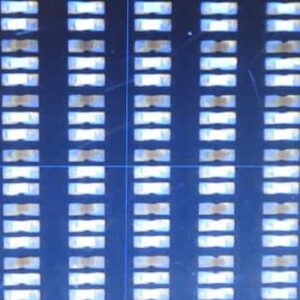
MICRO LED is the latest fine pitch LED display technology and allows LED screen manufacturers to create ultra-fine pixels pitches the can reach sub 1mm. The technology is inorganic and does not suffer from image retention, burn-in, and can reach brighter levels while consuming less power. So what is the difference between conventional/mini LED displays and micro-LED? Well, it is pretty complicated, and this is another subject where there seems to be some confusion. The best way to explain the difference is that micro-LED doesn’t usually have a substrate where the mini LED does. Mini LED has a pixel pitch range of 0.1mm – 1mm, and Micro LED ranges from anywhere below 0.1mm.
Video Processors
Okay, so you now know what kind of LED pixel pitch you want to consider and what size you would like your LED video wall, but how about controlling it? When it comes to the hardware inside your LED display, the most popular and, in our opinion, the best manufacturer is Novastar. Nowadays, nearly all of the top LED display manufacturers adopt their receiver cards inside their screens as they have so many features and are very reliable compared to most of the competition.

There are two main types of LED video processors –
Asynchronous LED Processors
These are LED controllers that are connected to an LED display and sent data/content that is then held on a chip within the display and plays without the need for another media player or video input to the screen. It is entirely independent of any other source and will usually continue to play until somebody re-connects to change the content. Connection methods vary but can include WIFI, USB, ethernet, and some of the latest models even include 3g or 4g network connections.
Synchronous LED Processors
Synchronous LED controllers require a video source that is always connected to the LED screen. This could be a media player, a PC, a video camera, or even a computer games console, basically anything with a video source output. The typical video sources used for synchronous LED video walls are HDMI, DVI, Display Port, and CVBS. Video scalers are commonly used when the output image from a video source is of a different aspect ratio to that of the LED screen. The video scaler will take this image and then output at the correct size to fit the video wall. Other uses include the ability to splice two or more sources together to create one big image or to use a feature called picture in picture or PIP, which enables two or more sources to be broken up into sections and shown on different parts of the LED display with just the press of a button.
Custom LED Screen configurations
One of Dynamo LED’s specialities is the commissioning of custom LED Displays. By custom, we mean anything other than the conventional, rectangle LED screens that are popular in ever more applications. With LED, it is possible to build in small increments, like brickwork, to create an almost bricks and mortar digital installation. Some of the digital installations we have created include shopfronts made entirely of LED modules with returns and soffits, LED towers that have right angles, and even double-decker buses and hot air balloons with LED screens attached.
Indoor LED Displays
Indoor LED screens are generally smaller than their outdoor counterparts but usually have a smaller pixel pitch due to the fact they are viewed from a closer distance. That’s not to say that they have any limitations on the size as they can also be made to any size required. Over the last few years, developments in technology mean that indoor LED displays can be used in far more applications, and they are now used as replacements for conventional TVs. Outdoor LED displays are most often used as advertising billboards but can also be seen in applications such as LED scoreboards or pitch side perimeter advertising. They need special protection from weather elements, and this level of security is referred to as the IP rating. Outdoor LED screens also have a shade that is situated above each pixel to stop direct sunlight from shining onto the screen and diluting the light that is emitted.
What is LED Pixel Pitch?
LED Pixel pitch is the distance between each pixel within an LED screen. A pixel pitch of 1mm means the space from one pixel to the next is 1mm. Some displays have a horizontal pitch and also a vertical pitch, so the vertical could be 5mm while the horizontal could be 10mm. The closer the pixel pitch, the higher the resolution, and as a result, the higher the cost of the LED display. Some manufacturers offer solutions called virtual pixel pitch. This is not something we would recommend as it basically adds another red, green, blue, or even white LED into the segment, which results in a loss of contrast due to less black space between the LEDs. Another con to virtual pixel displays is the fact that often manufacturers will use an additional LED which uses more power and so the brightness settings will be set lower, over time the other colours will see more degradation than the lower brightness LED, and the screen will require calibration to equal this out.
LED TV Pixel Pitch
If you only anticipate having an amazing view from your TV, then pixel pitch is the factor that you should consider the most. This means that the smaller the pitch of the pixels, the greater will be the pixel density, and hence, better will be the image quality. For indoor TVs, you can consider one with a low pixel pitch so that you can have the best picture quality.
LED Brightness
LED screen brightness is normally measured in nits per m2 and can vary depending on pixel pitch and whether the LED display will be used indoor or outdoor. Indoor LED displays have a brightness range of 500 nits to 3,000 nits, whereas outdoor LED screens are normally rated from 4,000 nits anywhere up to 12,000 nits or more. LED brightness can be one of the factors to consider when buying an LED screen. For instance, if an LED screen is to be situated in a bright window, a standard indoor brightness display will not be suitable when direct sunlight hits the display.
Recommended LED TV Brightness
Different LED TV screens have a variety of brightness. Before picking the one, consider the NIT rating of the TV. NIT will let you know about the brightness of the display screen and will also guide you upon which one you should buy.
If you are planning to buy one for indoor, keep the brightness between 500 to 2,500 NITS. If the value increases, it won’t be suitable for an indoor television. Resolution is determined by the number of pixels within an LED display and choosing the required resolution often depends on what content is going to be shown as well as the size of the display. For instance, if you are installing an LED screen into a control room environment where intricate content will be shown, then a high resolution will be needed, but sometimes a low resolution is acceptable. An example of this could be LED signs that will show traffic information such as stop signs or scoreboards at sports stadiums.
There is no denying the fact that LED display’s come in various sizes and shapes. Each size will have different resolution technology. People usually consider buying either a 720p ready HD screen or a 1080p full HD screen.
Best LED TV Resolution
When it comes to choosing a LED TV screen, people usually consider buying either a 720p ready HD screen or a 1080p full HD screen. However, as per the user experience, the latter would be better for an LED TV as it provides a detailed resolution and also enhances the picture quality. Buying 720-pixel size would be futile if you are considering a high definition screen panel, lit by numerous small LEDs.
Technical LED Specifications
Reading the specifications sheet for an LED display can sometimes be a very daunting task. With segments such as scan rate, refresh rate, pixel density, etc., things can get a little confusing. To help you understand what each of these factors means, we have put together the following to help buyers understand the terms used on most technical sheets.
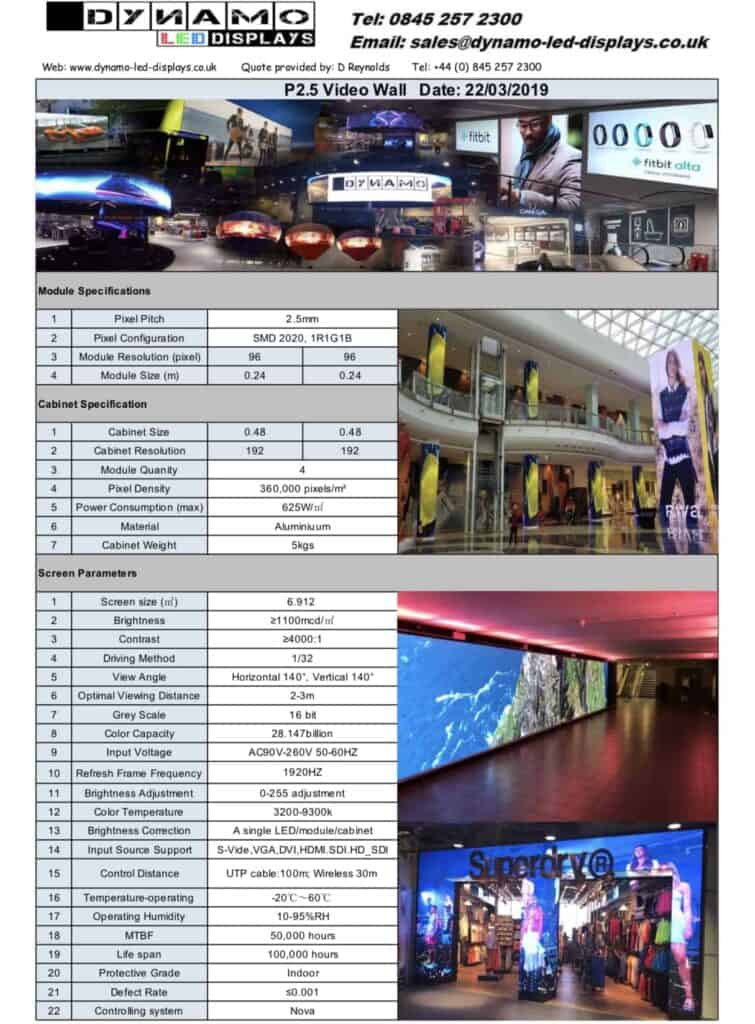
Pixel Pitch
As we covered earlier, the pixel pitch is the distance between each pixel. The closer the pixels, the higher the resolution, and the more clear the picture will appear. Currently, the lowest pixel pitch is around 0.6mm, although these displays are not currently live in the field. Outdoor LED displays could vary and can even exceed 100mm.
This is how the LED is packaged, the size of the LED, and also the kind such as DIP, SMD, or COB. An example would be SMD 2020 1R 1G 1B, which means the spec is for a surface mount device, 20mm x 20mm pixel containing one red, one green, and one blue LED.
LED Display brightness is usually measured in nits over a meter squared (cd/m2) and can vary enormously depending on the type of LED used and whether it will be used for indoor or outdoor applications. As a rule of thumb, indoor LED displays will have a brightness of 500 nits to 3,000 nits, and outdoor LED displays will start at around 4,000, and depending on the type of display, they can reach over 12,000.
Pixel Density
Pixel density is the number of pixels in any given area. A pixel is normally made up of a red, green, and blue LED in a full-colour solution, but can also be one individual pixel in mono colour for instance. pixel density is usually measured in pixels per meter square so for instance, a 2.5mm pixel pitch will have a pixel density of 400 x 400 and be 160,000 per m2.
LED refresh rate is the number of times the display changes frames or, in other words, the image that is displayed. Most LED displays are above 240hz, but in configuration settings, we can adjust these numbers depending on how the display will be used. To do this, we can sacrifice other settings such as colour range. For some settings, however, such as when the display will be filmed with a camera, it is essential to adopt a high refresh rate. We usually recommend at least 1920hz for these scenarios.
One of the biggest benefits of LED displays is the extremely high levels of contrast that are available. Contrast is the difference between the white and black images that the screen is able to show. The larger the difference in contrast, the better the picture quality, especially when watching darker content on the screen.
LED Viewing Angle
LED display viewing angle is far superior to nearly all of its competition due to the fact that the light creating the image emits directly off of the surface as opposed to sting through it or onto it like other solutions such as LCD or projection. Most LED screens have a viewing angle of at least 100º but vary both horizontally and vertically and can reach up to 170º.
LED greyscale is basically what it sounds like. It is the number of levels, on a scale that an LED display can show between shades of color. There are 256 levels of intensity, and so the highest possible greyscale is calculated at 24 bits, whereas the lowest amount would be 1 bit or two colors such as black and white.
LED Scan Rate
The scan rate is how many lines of the LED module the chip will change at any given time. The scan rate will usually be considered alongside the refresh rate, and we usually specify our LED displays scan rate depending on their environments. For instance, in a hot outdoor location, we prefer to use a lower scan rate so that the LED chips are not working so hard and have a longer lifetime.
LED life span indicates the expected lifetime of usage for an LED Display. This is usually 100,000 hours of use or 11 and a half years, which is quite a significant amount of time. Even when there are failures within an LED display, the modular nature means that all is required to fix the display is to simply replace the component that has failed, such as a receiver card or PSU.
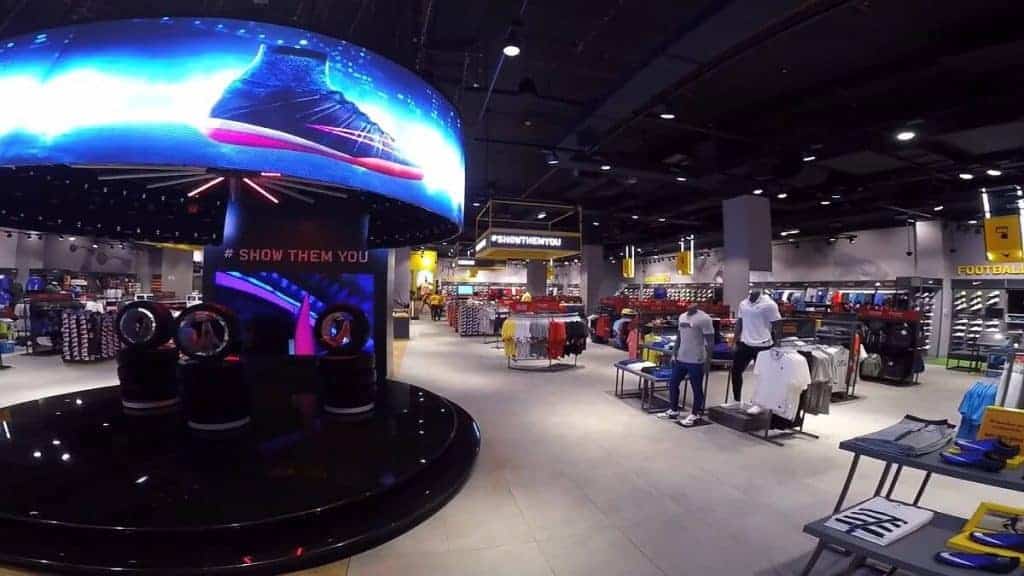
It is the quality of these LED-operated devices that distinguish them from the rest and makes them the favourite electronic appliances to possess. What normally is a 5000-hour life guarantee of an LED light is often reduced drastically if the quality is not up to the mark. As consumers, it becomes your responsibility to be aware of the essential difference between high-quality and low-quality LED lights so that you can get the maximum worth for your bucks.
Thereby, here are some outlined points that can help you understand the difference between high quality and low quality LED lights, in order to make a more informed purchase decision:
Construction
First comes first, it is very important to look at how well constructed the whole LED light is. One must check the design, look at the strength and the feel while choosing an appropriate light. An indicator of low quality would be careless and quick powder coating on the light, or cheap looking LED modules, which would also mean a cheaper inner construction. You should keep these things in mind while making the purchase.
Power Supply
LEDs are semiconductors that are driven by constant current DC supplies for longer life. In case of low-quality LED products, they are usually accompanied by low-quality components and low life capacitors, which will almost certainly reduce the life and make the display unreliable. Things to look out for are CE certification, which most of the low-quality supplies do not have. Here at Dynamo, we prefer to use Meanwell power supplies, which are very high quality with CE certification.
Weight
Although this sounds odd, it is true that a high quality LED light will weigh more than a low-quality one, mainly because of the good amount of aluminium for heat dispassion. Lights that feel like plastic cannot perform well, even when the time period is short.
Optics
Since LED lights have become integral parts of interior design, many people do not know how to distinguish between lights according to their purpose. Many cheap quality lights have the same optics for most of the LED lights, which basically means that a spot light’s range will be the same as the one used in the hall. One should also not opt for lights with opaque covers, as they hide the cheap components in an LED light.
LED Chip
There are suppliers worldwide for LED chips, one of the main components in LED displays. The larger the chip, the better the quality, light, and stability. However, they are also more expensive than the small and inexpensive LED chips that come with less light and stability. It is all a matter of the materials used in making the chip. Macroblock is one of our favourite manufacturers, but there are many variations that takes somebody with expert knowledge to specify the correct chips for the specific application.
Keeping these factors in mind, there is quite a bit that goes into the making of the quality of an LED light. Next time you see an LED display, cross-check these points with yourself and the LED appliance you want to buy. Once checked thoroughly, only then make the final purchase.
LED Mounting Solutions
LED screens can be mounted in various ways. Some screens can be fixed directly to walls, whereas some displays require that special frames are built to accommodate the LED cabinets. Many companies are now starting to produce mounting solutions that fit multiple manufacturers’ LED cabinets. One of the most important things to consider when selecting an LED mounting solution is how to maintenance will be carried out if necessary. Most LED cabinets these days allow for both front and back maintenance of all the components.
LED Calibration
LED screens are usually built in batches, which means the LEDs are supplied calibrated from the factory and ensures that the levels of brightness, contrast, and the colours of the LEDs are all equal. Calibration using the kind of expensive camera equipment that Dynamo LED has invested in can also give that extra bit of quality, which is why all of our screens have that added bit of “Wow Factor.”
